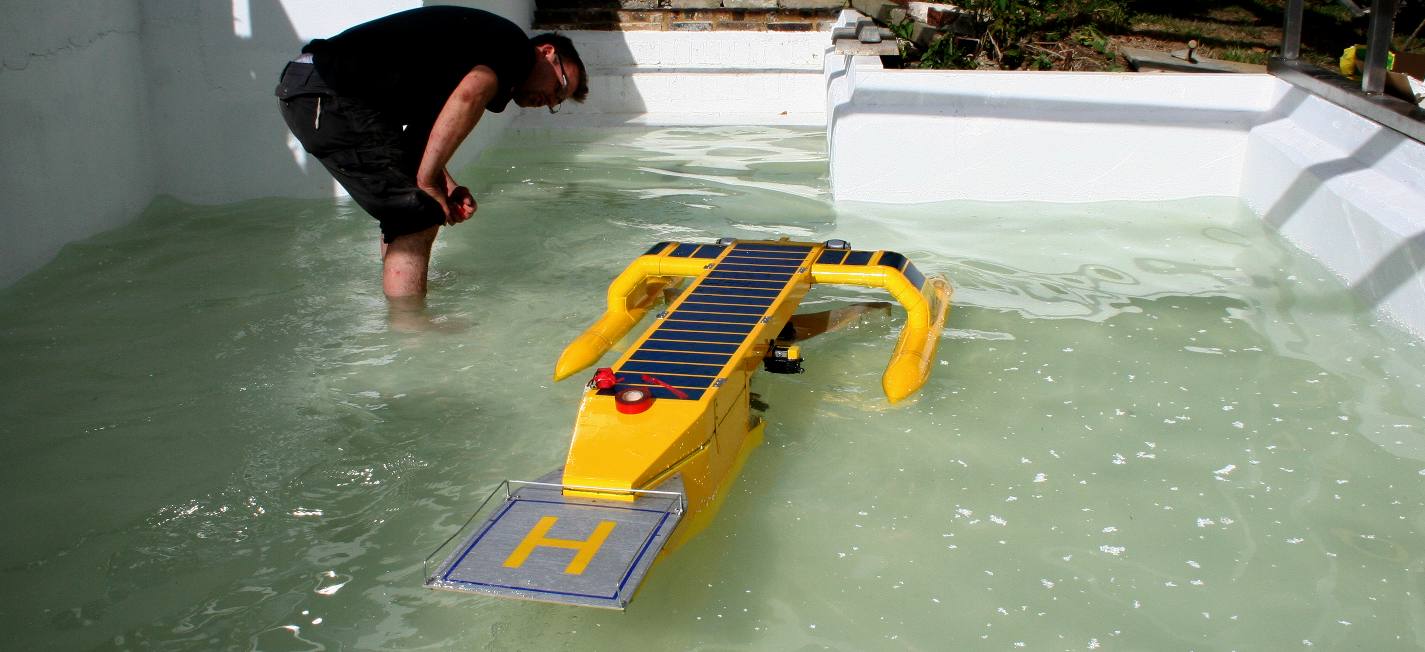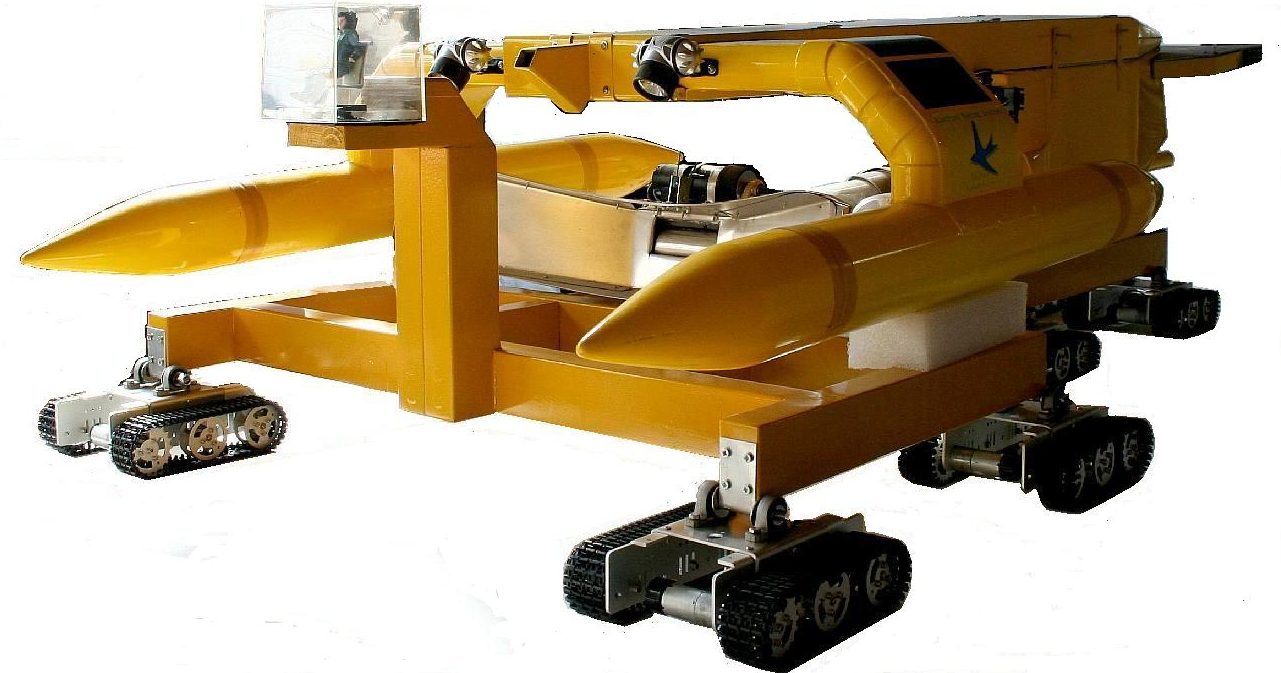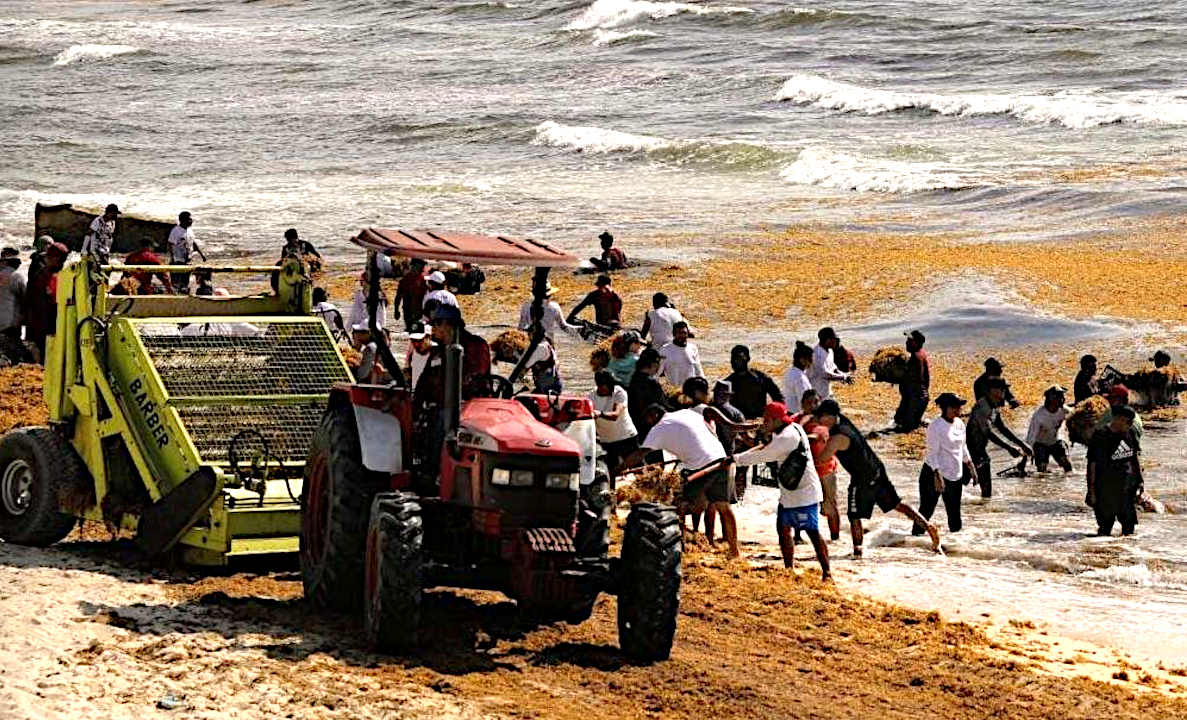|
SEAVAX - CALYPSO ™ OCEAN CLEANING MACHINES
Please use our A-Z INDEX to navigate this site, or return HOME
BIOMASS - BUILDING MATERIALS - CANCER - CLOTHING & SHOES - CO2 SEQUESTRATION - COSMETICS FERTILIZERS - FOODS - MEDICINES - MINERALS - PACKAGING - SUPPLEMENTS - VITAMINS
|
|
|
|
|
|
COMBINED HARVESTER - The basic SeaVax machine seen here as a proof of concept (working model) was designed to filter macro & micro plastics from seawater - in bulk, and recover ghost fishing nets of up to 150 tons. It was to be solar and wind powered. The Calypso and Sargasso (seaweed) models are roughly double and quadruple the capacity respectively, with a revised specification that includes renewable hydrogen in the energy equation, for more operational grunt and versatility. Calypso machines would operate at 10:1 with AmphiMax launch and recovery machines, servicing ten harvesters.
To many, sargassum is a plague, brought on by global climate change that is warming our oceans. But, with machines like the proposed 'SeaVax-Sargasso' adaptation, we can not only rid the Gulf of Mexico and Caribbean Islands of the nuisance seaweed that is choking their beaches - but turn the tables - out of the catastrophe in the making; to advantage mankind. For example there is a world shortage of fertilizer, that sargassum could help to plug.
OCEAN CLEANING MACHINES - This is what SeaVax looked like in 2016. The proof of concept model successfully cleaned our water test tank of scaled micro and macro plastics in minutes. The SeaVax-Calypso concept will need to be tested in our water basin, before constructing anything larger for the Caribbean Sea. Some of the specialist machinery can be developed using this low-cost facility.
Using the SeaVax formula as a baseline (example), a SeaVax-Sargasso™ and AmphiMax-Sargasso™ duo, would be out of reach of most island economies, cost wise. This is more for an ocean initiative that would likely need to be a G20, state funded joint venture. But at this time there is no agreement between parties to cooperate, let alone an action plan. That may of course change as the situation worsens.
Whereas, a SeaVax-Calypso™, working with an AmphiMax-Calypso™ might be music to the ears of tour and holiday operators in, or bordering the Caribbean Sea, if it is that pristine sandy beaches are a prerequisite for confident hotel bookings, without the familiar brown horizon, and noxious 'rotten-egg' odours to upset holiday makers.
In deference to G20 indifference, islanders may want to take charge of their own future, secured via a shore cleaning operation cooperative. Operations would be far more effective if the 30 or so larger islands worked together to cover each other's backs - and formulate a more coordinated response to sargassum seaweed. By way of a freedom movement from economic capitalist oppression beyond their control, a form of enslavement, from fossil fuel exploitation by the world's playground bullies.
If that or any similar plan were on the table, the Cleaner Ocean Foundation would welcome expressions of interest (by way of end users or partners) in their SeaVax-Calypso concept - with a view to seeking funding for such development and freedom from third-party industrial effluence.
With bumper harvests in the offing, what is at present a plague, may be transformed into an income stream.
AMPHIBIOUS BEACH RECOVERY - This concept was proven at 1:20 scale between December 2021 and January 2022, when the model seen above successfully transported the 1:20 scale SeaVax proof of concept boat, also performing variable tracked steering maneuvers. The AmphiMax series of beach launch and recovery transporters are designed to be rugged and economical to build, with hydraulically driven caterpillar tracks, resistant to seawater corrosion.
HOW DID WE GET IN THIS MESS?
Climate change is responsible for warming and acid oceans. But to tackle the root cause of the sargassum crisis, via cooling of the planet would take another 30-50 years - and only then if governments were to put the development brakes on and engage economic reverse gear today. Which is not about to happen, with present election strategies based on business as usual and economic growth promises (blah, blah, blah) that cannot be kept, as the borrowing bubble increases to fund such deception. Leading to national debts that are out of control. But that has been going on for the last 50 years. Politics is not about to change. We need to work around obstinate politicians and policies. So driving change in spite of them.
Research tells us that sargassum is often garnered from shallow waters (Monroy-Velázquez et al., 2019) or, more regularly, beach sites (Oliveira et al., 2015). It is recommended in such studies that pelagic Sargassum be garnered while it is still at sea, preferably near the shore, to prevent a negative visual impact on the waterfront and the unpleasant and detrimental smell produced by decomposing leachates and organic matter.
Dakatso (2021) proposed that the best strategy is to collect the Sargassum in large quantities using variable-sized nets (to avoid killing local marine fauna) at reef lagoons, shallow waters, or high seas. Following collection, transferring Sargassum to freshwater is advised to induce osmotic shock and allow motile fauna to detach from the algae (Monroy-Velázquez et al., 2019).
The net method involves manual labor at a scale that may not keep up with the influx of the seaweed. Whereas, mechanical harvesting involving suitable pre-treatments to (as far as possible) protect and encourage fauna detachment, is seen as a viable solution.
SEAVAX-CALYPSO™ (DRAFT) SPECIFICATIONS (SARGASSUM HARVESTER) 2023:
*
Electric thrusters = TBA.
* Autonomous navigation system for fleet integrated (drone) sargassum sweeps.
* Remote control, for islands wishing to opt out of fleet operations.
HOW ARE THEY COPING AT THE MOMENT?
Sargassum arrives ‘free of charge’, but from lessons learnt over the last decade, a large labor force and/or specialized machinery and equipment are required for effective large-scale shoreline or in-water collection, and to minimize environmental damage.
Transferring sargassum from boat harvesters and from onshore mechanized rakes and stockpiles to other means of transport also requires grabs, conveyors or other customized solutions, all of which can be very costly.
At certain places, booms (barriers) are used to keep either tourist or public beaches clean from the seaweed; these booms need to be specially designed to efficiently retain sargassum, with firm anchorage to the seafloor, and in addition require regular cleaning usually by special harvesting boats, elevating costs.
The methods and equipment need to be customized across a wide range of physical conditions found at different sites, such as the prevailing winds and sea conditions, water depth, nearshore habitats, environmental sensitivity, shoreline type (rocky, sandy, cliff, artificial), beach slope and width, and site access, among others.
After or during collection, and depending on the end use, sargassum may need sorting to provide a suitable raw material for further processing or to prevent damage to the environment. A system for scaring off or removing associated fauna, such as sea turtle hatchlings, from sargassum collected off-shore should be established to protect fauna that seeks refuge in the mats.
Separating sand from sargassum collected on the beach is very important to prevent beach erosion. Depending on the destination of sargassum, removing other beach wrack (e.g., seagrasses, other seaweeds), marine debris (e.g., plastics) and flotsam (e.g., driftwood) from sargassum harvested either at sea or from the beach may be necessary.
Separating fresh sargassum from partially decayed or dried sargassum is also an issue for uses that require high quality fresh seaweed, and would likely require at-sea collection.
SeaVax-Calypso addresses these concerns:
There are no diesel costs. Solar power provides energy for harvesting operations, while transits are green hydrogen powered. Green hydrogen based fuels are now coming on stream at many ports. We'll be looking at using micro electrolyzer installations for own island hydrogen (in-situ) generation, as part of quoting for any system.
WHAT DRIVES US - It is pictures like this beach at Cuncun, Gulf of Mexico, stinking to high heaven with sargassum, that is ruining the local economy and ecology, that makes us want to do something about it. You can too. Why not begin a research project for your masters degree. Work with the Cleaner Ocean Foundation, to make a difference to the world your great grandchildren will inherit - if they are lucky.
LINKS & REFERENCE
http://
|
|
|
"Be the solution, not the pollution."
BIOMASS - BUILDING MATERIALS - CANCER - CLOTHING & SHOES - CO2 SEQUESTRATION - COSMETICS FERTILIZERS - FOODS - MEDICINES - MINERALS - PACKAGING - SUPPLEMENTS - VITAMINS
|
|
|
Please use our A-Z INDEX to navigate this site, where page links may lead to other sites
This website is provided on a free basis as a public information service. copyright © Cleaner Oceans Foundation Ltd (COFL) (Company No: 4674774) 2022. Solar Studios, BN271RF, United Kingdom. COFL is a not for profit company without share capital. The names AmphiMax® and SeaVax® are registered trademarks.
|


